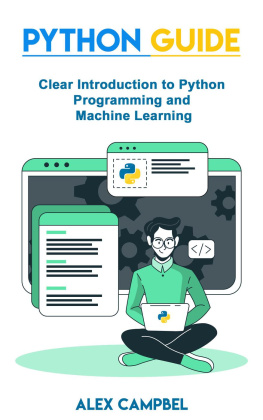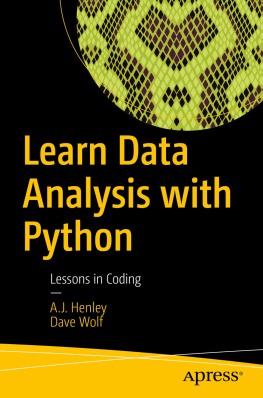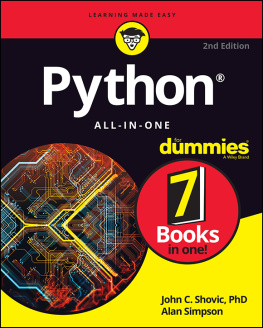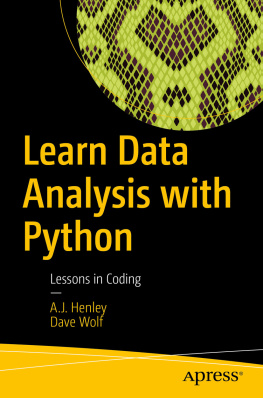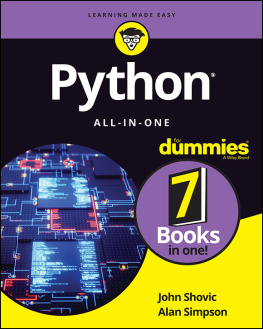

Python All-in-One For Dummies
Published by: John Wiley & Sons, Inc., 111 River Street, Hoboken, NJ 07030-5774, www.wiley.com
Copyright 2019 by John Wiley & Sons, Inc., Hoboken, New Jersey
Published simultaneously in Canada
No part of this publication may be reproduced, stored in a retrieval system or transmitted in any form or by any means, electronic, mechanical, photocopying, recording, scanning or otherwise, except as permitted under Sections 107 or 108 of the 1976 United States Copyright Act, without the prior written permission of the Publisher. Requests to the Publisher for permission should be addressed to the Permissions Department, John Wiley & Sons, Inc., 111 River Street, Hoboken, NJ 07030, (201) 748-6011, fax (201) 748-6008, or online at www.wiley.com/go/permissions .
Trademarks: Wiley, For Dummies, the Dummies Man logo, Dummies.com, Making Everything Easier, and related trade dress are trademarks or registered trademarks of John Wiley & Sons, Inc. and may not be used without written permission. All other trademarks are the property of their respective owners. John Wiley & Sons, Inc. is not associated with any product or vendor mentioned in this book.
LIMIT OF LIABILITY/DISCLAIMER OF WARRANTY: THE PUBLISHER AND THE AUTHOR MAKE NO REPRESENTATIONS OR WARRANTIES WITH RESPECT TO THE ACCURACY OR COMPLETENESS OF THE CONTENTS OF THIS WORK AND SPECIFICALLY DISCLAIM ALL WARRANTIES, INCLUDING WITHOUT LIMITATION WARRANTIES OF FITNESS FOR A PARTICULAR PURPOSE. NO WARRANTY MAY BE CREATED OR EXTENDED BY SALES OR PROMOTIONAL MATERIALS. THE ADVICE AND STRATEGIES CONTAINED HEREIN MAY NOT BE SUITABLE FOR EVERY SITUATION. THIS WORK IS SOLD WITH THE UNDERSTANDING THAT THE PUBLISHER IS NOT ENGAGED IN RENDERING LEGAL, ACCOUNTING, OR OTHER PROFESSIONAL SERVICES. IF PROFESSIONAL ASSISTANCE IS REQUIRED, THE SERVICES OF A COMPETENT PROFESSIONAL PERSON SHOULD BE SOUGHT. NEITHER THE PUBLISHER NOR THE AUTHOR SHALL BE LIABLE FOR DAMAGES ARISING HEREFROM. THE FACT THAT AN ORGANIZATION OR WEBSITE IS REFERRED TO IN THIS WORK AS A CITATION AND/OR A POTENTIAL SOURCE OF FURTHER INFORMATION DOES NOT MEAN THAT THE AUTHOR OR THE PUBLISHER ENDORSES THE INFORMATION THE ORGANIZATION OR WEBSITE MAY PROVIDE OR RECOMMENDATIONS IT MAY MAKE. FURTHER, READERS SHOULD BE AWARE THAT INTERNET WEBSITES LISTED IN THIS WORK MAY HAVE CHANGED OR DISAPPEARED BETWEEN WHEN THIS WORK WAS WRITTEN AND WHEN IT IS READ.
For general information on our other products and services, please contact our Customer Care Department within the U.S. at 877-762-2974, outside the U.S. at 317-572-3993, or fax 317-572-4002. For technical support, please visit https://hub.wiley.com/community/support/dummies .
Wiley publishes in a variety of print and electronic formats and by print-on-demand. Some material included with standard print versions of this book may not be included in e-books or in print-on-demand. If this book refers to media such as a CD or DVD that is not included in the version you purchased, you may download this material at http://booksupport.wiley.com . For more information about Wiley products, visit www.wiley.com .
Library of Congress Control Number: 2019937504
ISBN 978-1-119-55759-3 (pbk); ISBN 978-1-119-55767-8 (ebk); ISBN 978-1-119-55761-6 (ebk)
Python All-in-One For Dummies
To view this book's Cheat Sheet, simply go to www.dummies.com and search for Python All-in-One For Dummies Cheat Sheet in the Search box.
Table of Contents
List of Tables
- Book 1 Chapter 1
- Book 1 Chapter 4
- Book 2 Chapter 1
- Book 2 Chapter 2
- Book 2 Chapter 3
- Book 2 Chapter 4
- Book 3 Chapter 2
- Book 3 Chapter 3
- Book 4 Chapter 2
- Book 5 Chapter 2
- Book 5 Chapter 3
- Book 6 Chapter 2
- Book 6 Chapter 4
List of Illustrations
- Book 1 Chapter 1
- Book 1 Chapter 2
- Book 1 Chapter 3
- Book 1 Chapter 4
- Book 2 Chapter 1
- Book 2 Chapter 2
- Book 2 Chapter 3
- Book 2 Chapter 4
- Book 2 Chapter 5
- Book 2 Chapter 6
- Book 2 Chapter 7
- Book 3 Chapter 1
- Book 3 Chapter 2
- Book 3 Chapter 3
- Book 3 Chapter 4
- Book 4 Chapter 2
- Book 4 Chapter 3
- Book 4 Chapter 4
- Book 5 Chapter 2
- Book 5 Chapter 3
- Book 6 Chapter 1
- Book 6 Chapter 2
- Book 6 Chapter 3
- Book 6 Chapter 4
- Book 7 Chapter 1
- Book 7 Chapter 2
- Book 7 Chapter 3
- Book 7 Chapter 4
Guide
Pages
Introduction
The power of Python. The Python language is becoming more and more popular, and in 2017 it became the most popular language in the world according to IEEE Spectrum. The power of Python is real.
Why is Python the number one language? Because it is incredibly easy to learn and use. Part of it is its simplified syntax and its natural-language flow, but a lot of it has to do with the amazing user community and the breadth of applications available.
About This Book
This book is a reference manual to guide you through the process of learning Python and how to use it in modern computer applications, such as data science, artificial intelligence, physical computing, and robotics. If you are looking to learn a little about a lot of exciting things, then this is the book for you. It gives you an introduction to the topics that you will need to go deeper into any of these areas of technology.
This book guides you through the Python language and then it takes you on a tour through some really cool libraries and technologies (the Raspberry Pi, robotics, AI, data science, and so on) all revolving around the Python language. When you work on new projects and new technologies, Python is there for you with an incredibly diverse number of libraries just waiting for you to use.
This is a hands-on book. There are examples and code all throughout the book. You are expected to take the code, run it, and then modify it to do what you want. You dont just buy a robot, you build it so you can understand all the pieces and can make sense of the way Python works with the robot to control all the motors and sensors. Artificial intelligence is complicated, but Python helps make a significant part of it accessible. Data science is complicated, but Python helps you do data science more easily. Robotics is complicated, but Python gives you the code that controls the robot. And Python even allows us to tie these pieces together and use, say, AI in robotics.
In this book, we take you through the basics of the Python language in small, easy-to-understand steps. After we have introduced you to the language, then we step into the world of Python and artificial intelligence, exploring programming in machine learning and neural networks using Python and TensorFlow and actually working on real problems and real software, not just toy applications.
After that, were off to the exciting world of Big Data and data science with Python. We look at big public data sets such as medical and environmental data all using Python.
Finally, you get to experience the magic of what I call physical computing. Using the small, inexpensive Raspberry Pi computer (its small, but incredibly popular) we show you how to use Python to control motors and read sensors. This is a lead-up to our final book, Python and Robotics. Here you learn how to build a robot and how to control that robot with Python and your own programs, even using artificial intelligence.
Next page


